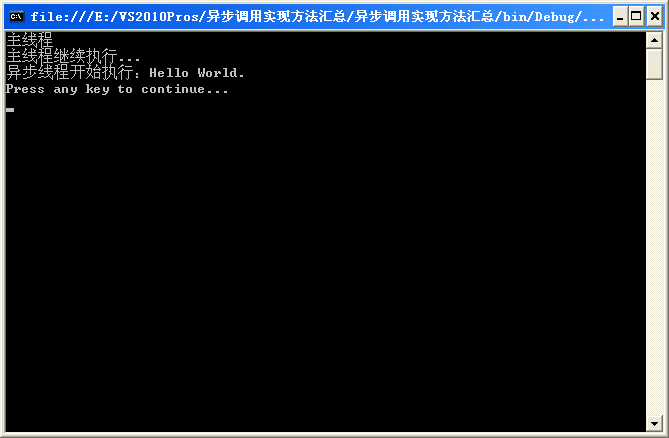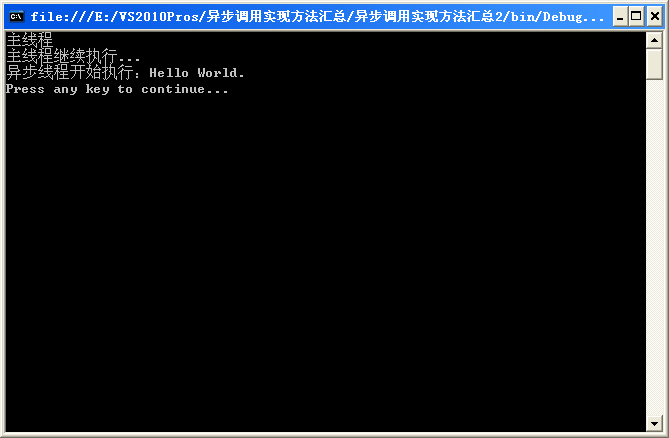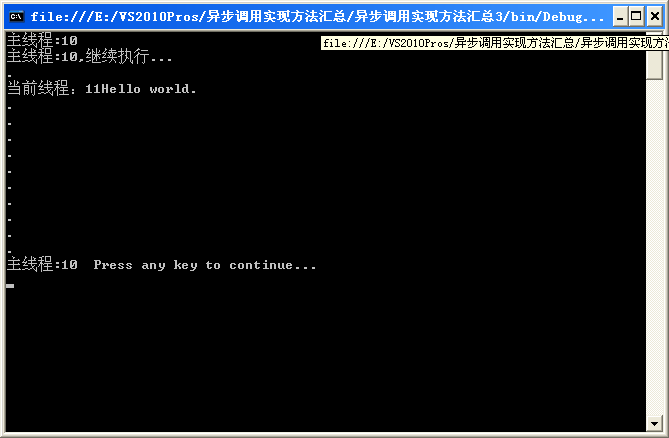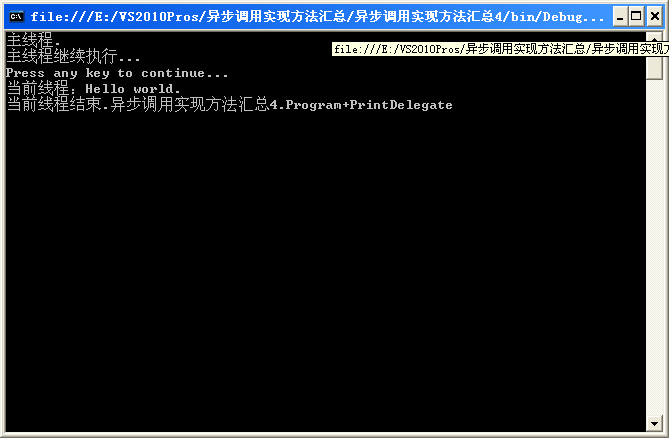最近很忙,既要外出找工作又要兼顧老闆公司的專案。今天在公司,忙裡偷閒,總結一下.NET中的異步調用函數的實現方法,DebugLZQ在寫這篇博文之前自己先動手寫了本文的所有示例代碼,開寫之前是做過功課的,用代碼說話方有說服力。
本文的內容旨在用最簡潔的程式碼來把非同步調用的方法說清楚,園子裡的高手老鳥可以繞行,不喜勿噴,非誠勿擾~
lz的前一篇文章簡單的說了下異步,主要是從理解上來講;這篇文章主要寫具體的實作方法。實作非同步程式有4種方法可供選擇,這4種訪求其實也對應4種非同步呼叫的模式,分為「等待」與「回呼」兩大類。四種方法,我在程式碼中都進行了詳細的註釋,這裡不囉嗦了,直接用程式碼說明吧
第一種方法:BeginEnvoke EndEnvoke方法,屬於「等待」類別。
using System;
using System.Collections.Generic;
using System.Linq;
using System.Text;
using System.Threading;
namespace 异步调用实现方法汇总
{
/// <summary>
/// 异步调用方法总结:
/// 1.BeginEnvoke EndEnvoke
/// 当使用BeginInvoke异步调用方法时,如果方法未执行完,EndInvoke方法就会一直阻塞,直到被调用的方法执行完毕
/// </summary>
class Program
{
public delegate void PrintDelegate(string s);
static void Main(string[] args)
{
PrintDelegate printDelegate = Print;
Console.WriteLine("主线程");
IAsyncResult result= printDelegate.BeginInvoke("Hello World.", null, null);
Console.WriteLine("主线程继续执行...");
//当使用BeginInvoke异步调用方法时,如果方法未执行完,EndInvoke方法就会一直阻塞,直到被调用的方法执行完毕
printDelegate.EndInvoke(result);
Console.WriteLine("Press any key to continue...");
Console.ReadKey(true);
}
public static void Print(string s)
{
Console.WriteLine("异步线程开始执行:"+s);
Thread.Sleep(5000);
}
}
}需要注意的地方,程式碼中都有註明了,程式運作結果如下:

第二種方法:WaitOne。同樣屬於「等待」類。
using System;
using System.Collections.Generic;
using System.Linq;
using System.Text;
using System.Threading;
namespace 异步调用实现方法汇总2
{
/// <summary>
/// 异步调用方法总结:
/// 2.WaitOne
/// 可以看到,与EndInvoke类似,只是用WaitOne函数代码了EndInvoke而已。
/// </summary>
class Program
{
public delegate void PrintDelegate(string s);
static void Main(string[] args)
{
PrintDelegate printDelegate = Print;
Console.WriteLine("主线程");
IAsyncResult result = printDelegate.BeginInvoke("Hello World.", null, null);
Console.WriteLine("主线程继续执行...");
result.AsyncWaitHandle.WaitOne(-1, false);
Console.WriteLine("Press any key to continue...");
Console.ReadKey(true);
}
public static void Print(string s)
{
Console.WriteLine("异步线程开始执行:" + s);
Thread.Sleep(5000);
}
}
}需要注意的地方,程式碼中都有註明了,程式運作結果如下:

第三種方法:輪詢。也是屬於「等待」類。
using System;
using System.Collections.Generic;
using System.Linq;
using System.Text;
using System.Threading;
namespace 异步调用实现方法汇总3
{
/// <summary>
/// 异步调用方法总结:
/// 3.轮询
/// 之前提到的两种方法,只能等下异步方法执行完毕,
/// 在完毕之前没有任何提示信息,整个程序就像没有响应一样,用户体验不好,
/// 可以通过检查IasyncResult类型的IsCompleted属性来检查异步调用是否完成,
/// 如果没有完成,则可以适时地显示一些提示信息
/// </summary>
class Program
{
public delegate void PrintDelegate(string s);
static void Main(string[] args)
{
PrintDelegate printDelegate = Print;
Console.WriteLine("主线程:"+Thread.CurrentThread.ManagedThreadId );
IAsyncResult result = printDelegate.BeginInvoke("Hello world.", null, null);
Console.WriteLine("主线程:" + Thread.CurrentThread.ManagedThreadId + ",继续执行...");
while (!result.IsCompleted)
{
Console.WriteLine(".");
Thread.Sleep(500);
}
Console.WriteLine("主线程:" + Thread.CurrentThread.ManagedThreadId + " Press any key to continue...");
Console.ReadKey(true);
}
public static void Print(string s)
{
Console.WriteLine("当前线程:" + Thread.CurrentThread.ManagedThreadId + s);
Thread.Sleep(5000);
}
}
}需要注意的地方,程式碼中都有註明了,程式運作結果如下:

第四種方法:回調。當然屬於「回呼」類別。推薦! ! ! !
之前三種方法者在等待非同步方法執行完畢後才能拿到執行的結果,期間主執行緒都處於等待狀態。回調和它們最大的區別是,在呼叫BeginInvoke時只要提供了回調方法,那麼主執行緒就不必要再等待非同步執行緒工作完畢,非同步執行緒在工作結束後會主動呼叫我們提供的回呼方法,並在回呼方法中做相應的處理。
using System;
using System.Collections.Generic;
using System.Linq;
using System.Text;
using System.Threading;
namespace 异步调用实现方法汇总4
{
/// <summary>
/// 异步调用方法总结:
/// 4.回调
/// 之前三种方法者在等待异步方法执行完毕后才能拿到执行的结果,期间主线程均处于等待状态。
/// 回调和它们最大的区别是,在调用BeginInvoke时只要提供了回调方法,那么主线程就不必要再等待异步线程工作完毕,
/// 异步线程在工作结束后会主动调用我们提供的回调方法,并在回调方法中做相应的处理,例如显示异步调用的结果。
/// </summary>
class Program
{
public delegate void PrintDelegate(string s);
static void Main(string[] args)
{
PrintDelegate printDelegate = Print;
Console.WriteLine("主线程.");
printDelegate.BeginInvoke("Hello world.", PrintComeplete, printDelegate);
Console.WriteLine("主线程继续执行...");
Console.WriteLine("Press any key to continue...");
Console.ReadKey(true);
}
public static void Print(string s)
{
Console.WriteLine("当前线程:"+s);
Thread.Sleep(5000);
}
//回调方法要求
//1.返回类型为void
//2.只有一个参数IAsyncResult
public static void PrintComeplete(IAsyncResult result)
{
(result.AsyncState as PrintDelegate).EndInvoke(result);
Console.WriteLine("当前线程结束." + result.AsyncState.ToString());
}
}
}需要注意的地方,程式碼中都有註明了,程式運作結果如下:

透過EndInvoke方法得到同步函數的回傳值。上面的同步方法回傳值為void,我們給個例子:
using System.Diagnostics;
using System.Threading;
using System.Windows;
namespace TestDelegateWrapper
{
/// <summary>
/// Interaction logic for MainWindow.xaml
/// </summary>
public partial class MainWindow : Window
{
public MainWindow()
{
InitializeComponent();
}
private void ButtonBase_OnClick(object sender, RoutedEventArgs e)
{
WrapperSyncMethodAsync("ABC");
Trace.WriteLine("Main thread continue...");
}
private delegate string SyncMethod1Delegate(string str);
private void WrapperSyncMethodAsync(string str)
{
SyncMethod1Delegate syncMethod1Delegate = SyncMethod1;
syncMethod1Delegate.BeginInvoke(str, x =>
{
var result= syncMethod1Delegate.EndInvoke(x);
// using the result to do something
Trace.WriteLine(result);
}, null);
}
private string SyncMethod1(string str)
{
Thread.Sleep(2000);
return str;
}
}
}輸出如下:
Main thread continue...
ABC
以上就是四種實現非同步呼叫函數的四種方法,說的很清楚了,就寫這麼多~希望對大家的學習有幫助,也希望大家多多支持腳本之家php中文網。




